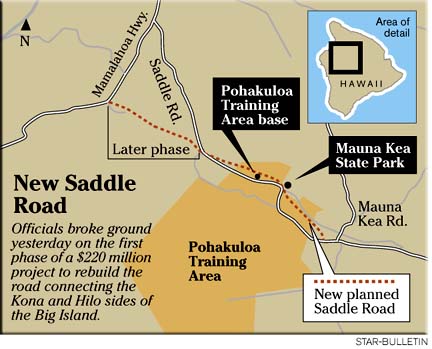
Long-awaited Saddle Road
upgrade gets startedPolitical leaders help break
ground on the $220 million project
MAUNA KEA STATE PARK, Hawaii >> Federal, state, and Hawaii County officials broke ground yesterday for the first phase of a planned $220 million rebuilding of the Saddle Road between East and West Hawaii.
The new road will be safer and faster for civilian and military traffic, speakers said at yesterday's ceremony.
The first phase, costing up to $50 million, will build a 12.7-mile road behind the Army's Pohakuloa Training Area base camp, replacing the road that now fronts the camp. The first phase is expected to be complete in about two years.
Because the road serves the roughly 109,000-acre Pohakuloa facility, about two dozen anti-military protesters demonstrated at yesterday's ceremonies, shouting throughout speeches by dignitaries.
The protesters objected to use of Pohakuloa for training with the new Stryker military vehicle. The protesters are opposed to greater military activity on the island.
Recognizing U.S. Sen. Daniel Inouye's key role in obtaining funding for the project, Hawaii County Mayor Harry Kim commented, "I know of no man that stands for peace (more) than Sen. Inouye."
Federal highways official Larry Smith said the project was "certified" for planning in 1989.
Inouye said, "This project started before the word 'Stryker' was ever heard."
Inouye said the project took so long because officials learned from mistakes made building the H-3 freeway in Honolulu that every detail had to be covered before construction could start.
Officials dismissed a newly suggested concern that construction of a later phase of the Saddle project could conflict with the Army's desire to obtain 23,000 acres of Parker Ranch land in the same area.
Pohakuloa commander Lt. Col. Fred Clarke said there would be no conflict because no live firing is planned in the 23,000-acre area.
Smith said the only accommodation that might be necessary would be some underpasses for military vehicles to drive under the highway.
The 47-mile Saddle Road was built by the Army in 1942 to provide military access to the high plateau between Mauna Kea and Mauna Loa.
The often narrow, crumbling, twisting roadway remains one of the most dangerous in the state with nearly twice the average state highway accident rate, according to an environmental study conducted for the road.
When rebuilt, the road is expected to carry 14,000 vehicles a day in 2014, up from 900 per day in 1994, the study said.
Inouye described it as a link between the politically and culturally different populations of East and West Hawaii.
U.S. Rep. Neil Abercrombie called it "something that has been a dream for many decades."
Cultural researcher Kepa Maly said the dream is even older. The Army's 1942 road followed the same alignment as the Hawaiian kingdom's horse and carriage road built through the area starting in 1869, he said.
The kingdom built the road for the same reason that Inouye mentioned, to tie together the eastern and western sides of the island, Maly said.

